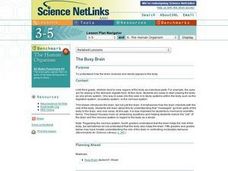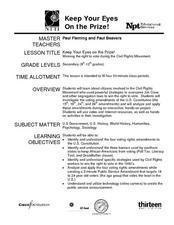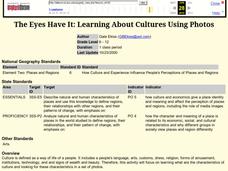Beyond Benign
Ecological Footprint
How does your lifestyle measure up in terms of your ecological footprint? Young ecologists examine their impact on the planet using an insightful online calculator. A short quiz asks users to rank the size of their homes, their energy...
Curated OER
The Learning Network: Poetry Pairing July, 21, 2011
Although not a complete lesson plan, this set of emotionally powerful texts could be used in a variety of lessons. From The New York Times' Learning Network site, the resource includes a poem, an excerpt from a New York Times article and...
National Nanotechnology Infrastructure Network
The Pinch Test
Test your pupils' understanding of the scale from macro to atomic. While displaying images of different materials, learners identify what they would need to make that material visible. Their choices range from the human eye to an...
California Academy of Science
Color Vision Genetics Evolution Simulation
At one point, all mammals carried only two color receptors, but now most humans carry three. An informative presentation and hands-on activity demonstrate how this evolved through genetics. By participating in the activity, pupils...
Baylor College
Drugs, Risks and the Nervous System
In cooperative groups, middle schoolers contemplate the probability of 18 different situations occurring. After they make predictions, they compare them to the actual risk factors. This eye-opening exercise demonstrates that the odds of...
Curated OER
Why Do People Fall in Love?
Students discuss human behavior, sexual selection and the underlying genetic and evolutionary reasons for mate selection. The, in groups, they rate the attractiveness of certain individuals and measure facial features for symmetry.
Curated OER
The Busy Brain
Learners explore biology by completing a human body worksheet. In this human brain lesson, students identify the different anatomy within the brain and the functions those pieces form. Learners read an article about signals in the brain...
Curated OER
Topic: Persuasive Speech
Students examine what makes a speech persuasive. In this speech lesson, students recognizes what is needed to make a good persuasive speech and create their own persuasive speech about something related to the human body.
Curated OER
Stanley Park and Aquarium Field Trip
Students explore the beauty of British Columbia by participating in a class field trip. In this ecosystem observation activity, students investigate the Vancouver Aquarium and Stanley Park, one of the largest parks in North America....
Curated OER
Dissection Scramble
Students discover the anatomy of a human body by dissecting a cow's eye. In this animal dissection lesson, students identify the structure of an eyeball by cutting open a cow eye and observing the insides. Students participate in an...
Curated OER
Keeping A Watchful Eye
Students explore the use of satellite surveillance systems to track criminals. They consider how the use of this technology in law enforcement might affect them and write opinions on whether or not such a system should be adopted by...
Curated OER
Variations on a Human Face Lab
Ninth graders gain an application level understanding of probability, symmetry, and ratios and rates that exists in one's everyday environment relative to human genetics.
Curated OER
Humans and the Natural World Poetically
Students read poetry for gist and find images to create a visual narrative. In this poetry lesson, students read Green Lane and Flies and Nettles to examine the relationship between humanity and the nature. Students reflect on a place...
Curated OER
Eye On the Environment Essay
Learners analyze the impact of human activity (e.g., population density, pollution) to a country where the target language is spoken. They prepare a three paragraph essay and describe the impact of pollution on the environment and the...
Curated OER
Keep Your Eye On the Prize
High schoolers learn about citizens who were actively involved in the civil rights movement, and the strategies they used to overcome the Jim Crow laws that were so prevalent in the 1960s. They investigate the voting amendments of the US...
Curated OER
The Real Bionic Man
Students examine the work that scientists have been doing to create artificial human parts. In this exploratory lesson students research the human eye and brain using the Internet.
Facing History and Ourselves
Eyes on the Prize Lesson 2: Six Steps for Nonviolent Social Change
Students explore the concept of nonviolent protest. For this Civil Rights lesson, students examine the attributes of nonviolent protest as they investigate the student protests that took place in Nashville in 1960-1961. Students reflect...
Cornell University
Thinking with the Eyes
Objects are larger (or smaller) than they appear! Scholars use a laboratory investigation to explore the difference between resolution and magnification. The activity allows them to calculate the size of the field of view of their light...
Messenger Education
Snow Goggles and Limiting Sunlight
Why would someone need contact lenses that offer UV protection? With a 28-page packet full of instruction and worksheets, students discuss solar radiation and its potential harm to eyes. They make snow goggles similar to ones hunters...
Curated OER
Winter Moves
Students discuss the effects of downhill motion on the body, and discern how the human eye perceives motion by studying Edward Muybridge's photography. They observe seasonal changes and identify elements related to the winter months in...
Curated OER
Faces in the Crowd Lesson Plan
Students examine the faces of other students in the classroom and the community. They determine the similarities and the differences in hair texture and color, skin tones, shapes of noses, and eyes. Using a glue mixture, they paint the...
Maryland Department of Natural Resources
Eyes on Dissolved Oxygen
Learn about the factors that affect the way oxygen dissolves in salt water with a chemistry lab. After studying the molecular structure of water, young scientists figure out how aeration, temperature, and organic waste affect dissolved...
Curated OER
The Eyes Have It: Learning About Cultures Using Photos
Young scholars focus on determining what the characteristics of culture are. They look for these characteristics in a set of photos. They complete a worksheet imbedded in this plan.
Facing History and Ourselves
Justice After the Holocaust
Though there could be no true justice for the horrors of the Holocaust, many of those responsible for crimes against humanity were found guilty in the eyes of the law. Using primary and secondary sources in the 16th installment of a...
Other popular searches
- The Human Eye
- Human Eye Powerpoint
- Drawing the Human Eye
- Human Eye Diagrams
- Parts of the Human Eye
- Label the Human Eye
- Biology Human Eye
- Human Eye Function
- Human Eye 5th Grade
- Human Eyesight
- Anatomy of the Human Eye
- Human Eye Reproducibles

























